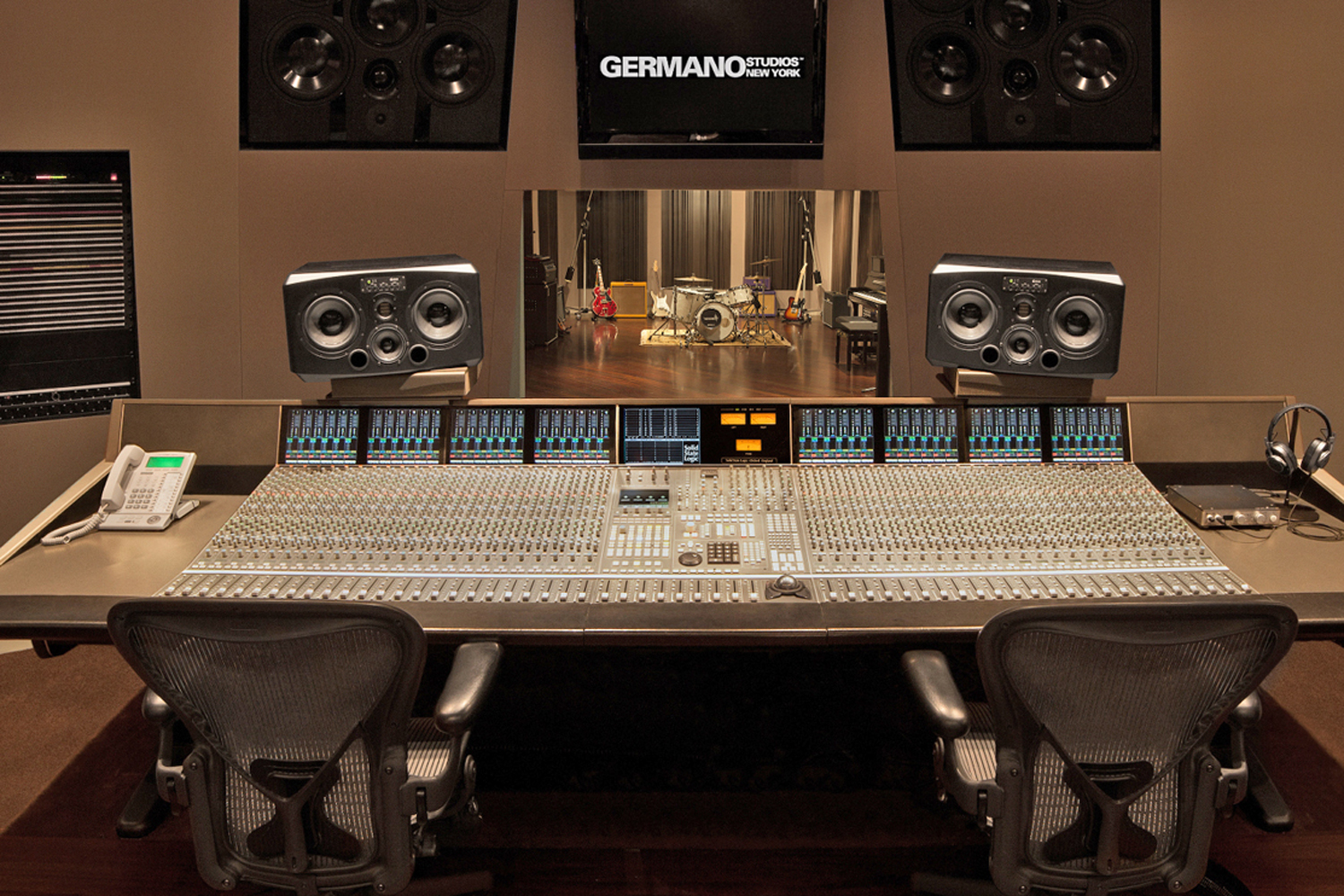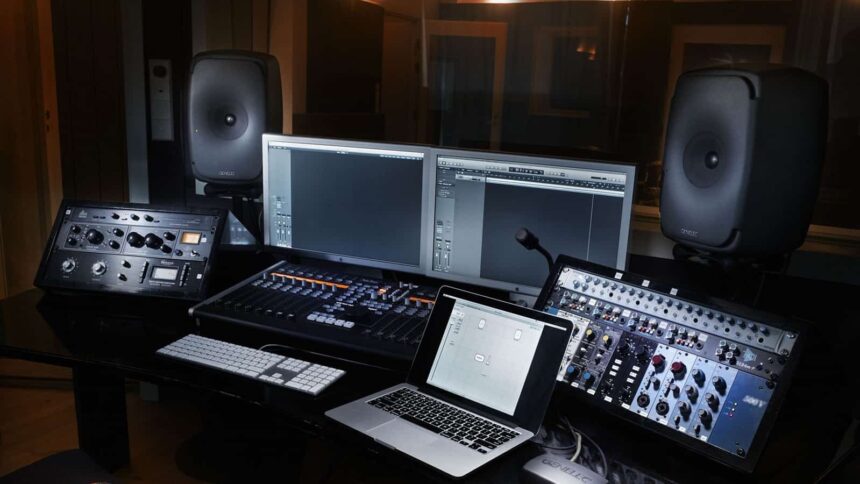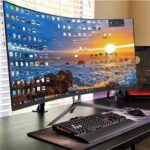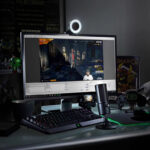Introduction
When it comes to creating music that resonates with both creators and listeners, the choice of music studio monitors becomes not just important but essential. These critical pieces of audio equipment serve as the window to the true sound of your recordings, allowing you to hear every nuance and detail of the music you’re creating. Selecting the perfect monitors for your studio is akin to choosing the right pair of glasses; what you opt for can drastically enhance or hinder your ability to produce and fine-tune your work. Whether you’re setting up a home studio or upgrading your existing setup, understanding the key features and factors that define the best music studio monitors is crucial. This guide will demystify the process, ensuring you make an informed decision that elevates the quality of your studio recording to professional standards, thereby improving your sound quality in leaps and bounds.
Understanding Music Studio Monitors
Definition and purpose of music studio monitors
Music studio monitors are specialized loudspeakers designed for audio recording and production environments. Unlike consumer speakers, which often enhance certain frequencies to make music sound more appealing, studio monitors aim for flat response, meaning they attempt to reproduce audio signals as accurately as possible without adding any coloration. This fidelity is crucial for audio engineers and producers, as it allows them to hear every detail of their work, ensuring the final mix sounds good on various playback systems, from high-end home stereo systems to car radios.
Importance of accurate sound reproduction in studio recording
The importance of accurate sound reproduction in studio recording cannot be overstated. It’s the foundation upon which a quality recording is built. When studio monitors provide a true representation of sound, mixing and mastering engineers can make precise adjustments to EQs, levels, and effects with confidence. Accurate monitors reveal minor flaws and nuances in recordings that might otherwise go unnoticed, such as subtle distortions, unwanted noise, or imbalances between instruments. This enables professionals to create mixes that translate well across different listening environments, ensuring the listener’s experience is as the artist intended. Without reliable studio monitors, critical mistakes can be overlooked, potentially compromising the quality of the final product.
Types of Music Studio Monitors
Active vs. Passive Studio Monitors

When selecting music studio monitors, one of the first decisions you’ll face is choosing between active and passive models. Active studio monitors have built-in amplification, meaning each speaker contains its own power source. This integrated design allows for optimal pairing between the amplifier and the speaker components, often resulting in more consistent and accurate sound reproduction. On the flip side, passive studio monitors require an external amplifier. While this means an extra piece of equipment and more complexity in setup, it also provides flexibility in customizing your audio system and can be beneficial if you already own a high-quality amplifier.
Near-field vs. Mid-field Studio Monitors

Another critical categorization is between near-field and mid-field studio monitors, which refers to the intended listening distance. Near-field monitors are designed to be placed close to the listener, typically within three to five feet. They are ideal for small to medium-sized studios where space is at a premium, and they help minimize the impact of room acoustics on the sound. This proximity allows for a clear, direct listening experience, making near-fields a popular choice among home studios and professional setups alike.
Mid-field monitors, in contrast, are designed for larger rooms and are positioned farther away from the listener, usually more than five feet. They offer a broader sweet spot and are capable of delivering higher volume levels and a more expansive soundstage. This makes mid-field monitors suitable for more extensive studio environments where the listening distance is greater, allowing engineers to better judge how a mix will sound in wide-ranging listening conditions.
Two-Way vs. Three-Way Studio Monitors

Lastly, the design configuration of studio monitors, specifically two-way and three-way systems, impacts their sound reproduction capabilities. Two-way monitors have two drivers: a woofer for low frequencies and a tweeter for high frequencies. This setup can effectively reproduce a wide range of sounds, making two-way monitors a versatile and cost-effective choice for many studios.
Three-way monitors, however, include an additional mid-range driver, allowing them to separate low, mid, and high frequencies more distinctly. This separation can result in clearer, more detailed sound reproduction, particularly in the critical midrange frequencies where human ears are most sensitive. Although three-way monitors tend to be more expensive, their enhanced clarity and detail can be invaluable for critical listening tasks, making them a worthy investment for serious professionals aiming to produce top-tier audio content.
Factors to Consider When Choosing Studio Monitors

Selecting the perfect music studio monitors is not just about picking the most expensive option or the one with the most reviews. It’s about understanding the factors that contribute to sound quality and how they fit into your unique recording setup. Let’s delve into crucial considerations to guide your choice.
Frequency Response and Flat Frequency
One of the paramount factors to consider is the frequency response of the monitor, which measures how accurately it can reproduce sound across the spectrum of audible frequencies. Ideally, you want a flat frequency response. This means the monitor plays back all frequencies at the same level, without artificially boosting or cutting any part of the frequency spectrum. This accuracy is critical for making precise mixing decisions, ensuring that your tracks sound great not just in your studio, but on any playback system.
The typical human ear can hear between 20 Hz to 20 kHz, and while no speaker can cover this entire range perfectly, the aim is to get as close as possible. Be wary of monitors that hype certain frequencies, as this can lead to mixes that sound great in the studio but fall flat elsewhere.
Power Handling and Amplification
The power of studio monitors, often measured in watts, is crucial for understanding how loud they can get without distorting sound. However, louder isn’t always better. What’s more important is the quality of the amplification and how it’s matched to the drivers. Many high-quality studio monitors are bi-amplified, meaning they have separate amplifiers for low and high frequencies, resulting in a clearer and more defined sound at any volume.
Considering the size of your room and how far you’ll be from the monitors while mixing is essential. In a smaller studio space, a pair of monitors with lower power might be perfectly adequate, while larger rooms may require monitors with more wattage for proper sound distribution.
Room Acoustics and Monitor Placement
Your recording space’s acoustics can significantly impact your monitors’ performance. Hard surfaces reflect sound, while soft materials absorb it, affecting what you hear during playback. Before investing in high-end monitors, it might be worth treating your room acoustically to ensure an accurate listening environment.
Monitor placement is also critical. Ideally, monitors should be positioned so that they form an equilateral triangle with your listening position, and at ear level. Furthermore, consider monitor stands or pads to isolate them from surfaces and minimize vibrations, which can color the sound.
Top Brands and Models in the Market
1. Yamaha HS8 Studio Monitor

Yamaha HS8 Studio Monitor
The Yamaha HS8 Studio Monitor is a flagship product renowned for its exceptional clarity and accuracy. Featuring an 8-inch cone woofer and 1-inch dome tweeter, these monitors deliver a frequency response of 38Hz to 30kHz, ensuring every nuance of your audio is faithfully reproduced.
Maker: Yamaha
Key Features:
- Bi-amplified design for precise sound reproduction
- Room control and high trim response controls for optimal sound adjustment
- XLR and TRS phone jack inputs for versatile connectivity
- Sleek and durable design suitable for professional studios
Benefits:
- Accurate sound reproduction for critical listening and mixing
- Versatile connectivity options for seamless integration into your studio setup
- Robust construction ensures long-term reliability
Pros:
- Exceptional sound clarity and accuracy
- Versatile connectivity options
- Sturdy build quality
Cons:
- Relatively high price point
- Bulky size may not be suitable for smaller studio spaces
2. KRK Rokit 5 G4 Studio Monitor

KRK Rokit 5 G4 Studio Monitor
The KRK Rokit 5 G4 Studio Monitor is a popular choice among musicians and producers for its balanced sound signature and affordable price. With a 5-inch woofer and 1-inch tweeter, these monitors offer a frequency response of 43Hz to 40kHz, making them ideal for various musical genres and audio applications.
Maker: KRK
Key Features:
- Built-in Class D amplifiers for powerful and efficient performance
- Front-firing port design reduces boundary coupling for enhanced clarity
- Onboard DSP-driven EQ presets for easy sound customization
- Robust MDF enclosure minimizes resonance and distortion
Benefits:
- Balanced sound suitable for mixing and monitoring
- User-friendly EQ presets for quick sound adjustments
- Compact and stylish design fits well in any studio environment
Pros:
- Affordable price point
- Clear and balanced sound
- Convenient EQ presets for customization
Cons:
- Limited low-frequency extension compared to larger monitors
- Some users report reliability issues over time
3. JBL Professional 305P MkII Studio Monitor

JBL Professional 305P MkII Studio Monitor
The JBL Professional 305P MkII Studio Monitor is lauded for its precise imaging and transparent sound reproduction. Equipped with a 5-inch woofer and 1-inch tweeter, these monitors deliver a frequency response of 49Hz to 20kHz, making them suitable for critical listening and mixing tasks.
Maker: JBL
Key Features:
- Patented Image Control Waveguide for accurate sound dispersion
- Dual integrated Class D amplifiers ensure high output and low distortion
- Boundary EQ settings compensate for room acoustics
- Sleek and modern design with a rugged enclosure for durability
Benefits:
- Precise imaging for detailed audio analysis
- Flexible EQ options for adapting to various studio environments
- Compact size ideal for desktop or near-field monitoring
Pros:
- Clear and detailed sound reproduction
- Compact and stylish design
- Versatile EQ adjustments for room optimization
Cons:
- Slightly limited low-end extension
- Some users report occasional reliability issues with the power supply
4. PreSonus Eris E5 Studio Monitor

PreSonus Eris E5 Studio Monitor
The PreSonus Eris E5 Studio Monitor offers professional-grade sound quality at an affordable price point. Featuring a 5.25-inch woven composite woofer and 1-inch silk dome tweeter, these monitors deliver a frequency response of 53Hz to 22kHz, making them suitable for various studio applications.
Maker: PreSonus
Key Features:
- Acoustic tuning controls for adjusting high and low-frequency response
- Balanced XLR, balanced ¼-inch TRS, and unbalanced RCA inputs for versatile connectivity
- RF interference protection ensures clean audio signal transmission
- Robust construction with a sleek and modern design
Benefits:
- Accurate sound reproduction for critical listening and mixing
- Flexible connectivity options for seamless integration into any setup
- Affordable price point without compromising on quality
Pros:
- Affordable price with professional-grade sound
- Versatile connectivity options
- Adjustable acoustic tuning controls
Cons:
- Some users find the high-end response slightly harsh
- Limited low-frequency extension compared to larger monitors
5. Mackie CR-X Series CR-X5 Studio Monitor

Mackie CR-X Series CR-X5 Studio Monitor
The Mackie CR-X Series CR-X5 Studio Monitor is designed for multimedia creators and music producers seeking a budget-friendly monitoring solution. With a 5-inch polypropylene-coated woofer and 0.75-inch ferrofluid-cooled silk-dome tweeter, these monitors offer a frequency response of 80Hz to 20kHz, making them suitable for desktop and small studio setups.
Maker: Mackie
Key Features:
- Convenient front-panel volume knob with lit power ring for easy adjustment
- All-wood cabinet design reduces resonance for clearer sound
- Professional-grade components ensure reliable performance
- Flexible input options including RCA, TRS, and Bluetooth connectivity
Benefits:
- Compact size ideal for desktop or small studio spaces
- Bluetooth connectivity for wireless audio streaming
- Affordable price point without sacrificing sound quality
Pros:
- Budget-friendly price
- Compact and stylish design
- Bluetooth connectivity for added convenience
Cons:
- Limited low-frequency response due to small woofer size
- Some users report Bluetooth connectivity issues
Review of top-rated studio monitor models
1. Yamaha HS8 Studio Monitor
Detailed Review:
The Yamaha HS8 Studio Monitor is a powerhouse when it comes to delivering accurate sound reproduction. Its 8-inch cone woofer and 1-inch dome tweeter combine to provide a frequency response that captures every detail of your audio. Whether you’re mixing tracks or simply enjoying music, the HS8 excels in providing a clear and transparent soundstage.
One of the standout features of the HS8 is its bi-amplified design, which ensures precise sound reproduction across the frequency spectrum. Additionally, the room control and high trim response controls allow you to fine-tune the monitor’s performance to suit your studio environment.
While the HS8 comes with a relatively higher price tag, its exceptional build quality and reliable performance make it a worthwhile investment for professionals and enthusiasts alike. However, its bulky size may not be suitable for smaller studio spaces.
Overall, the Yamaha HS8 Studio Monitor sets the benchmark for accuracy and clarity in the world of studio monitors, making it a top choice for discerning audio professionals.
2. KRK Rokit 5 G4 Studio Monitor
Detailed Review:
The KRK Rokit 5 G4 Studio Monitor is a popular option among musicians and producers for its balanced sound signature and affordability. Featuring a 5-inch woofer and 1-inch tweeter, the Rokit 5 G4 offers a wide frequency response that caters to various musical genres and studio applications.
One of the standout features of the Rokit 5 G4 is its built-in Class D amplifiers, which deliver powerful and efficient performance without compromising on sound quality. The front-firing port design further enhances clarity by reducing boundary coupling, ensuring that your audio remains precise and articulate.
Additionally, the onboard DSP-driven EQ presets make it easy to customize the monitor’s sound to your liking, whether you’re mixing tracks or simply listening to music. However, some users have reported reliability issues over time, so it’s worth considering this aspect before making a purchase.
Overall, the KRK Rokit 5 G4 Studio Monitor offers an excellent balance of performance and affordability, making it a popular choice for both beginners and experienced audio professionals.
3. JBL Professional 305P MkII Studio Monitor
Detailed Review:
The JBL Professional 305P MkII Studio Monitor is revered for its precise imaging and transparent sound reproduction. With a 5-inch woofer and 1-inch tweeter, the 305P MkII delivers a frequency response that captures every nuance of your audio, making it ideal for critical listening and mixing tasks.
One of the key highlights of the 305P MkII is its patented Image Control Waveguide, which ensures accurate sound dispersion for optimal listening experiences. Additionally, the dual integrated Class D amplifiers provide high output and low distortion, ensuring that your audio remains clean and faithful to the original source.
The monitor’s sleek and modern design, coupled with its rugged enclosure, ensures both style and durability. However, some users have noted occasional reliability issues with the power supply, so it’s essential to keep this in mind when making a purchase decision.
In summary, the JBL Professional 305P MkII Studio Monitor sets the standard for precision and clarity in studio monitoring, making it a top choice for discerning audio professionals.
4. PreSonus Eris E5 Studio Monitor
Detailed Review:
The PreSonus Eris E5 Studio Monitor offers professional-grade sound quality at an affordable price point. With a 5.25-inch woofer and 1-inch silk dome tweeter, the Eris E5 delivers a frequency response that ensures accurate sound reproduction for critical listening and mixing tasks.
One of the standout features of the Eris E5 is its acoustic tuning controls, which allow you to adjust the monitor’s high and low-frequency response to suit your preferences and studio environment. Additionally, the monitor offers a range of connectivity options, including balanced XLR, balanced ¼-inch TRS, and unbalanced RCA inputs, ensuring compatibility with various audio devices.
While the Eris E5 offers professional-grade sound at a budget-friendly price, some users have found the high-end response slightly harsh. Additionally, its limited low-frequency extension may not be sufficient for users who require deep bass reproduction.
Overall, the PreSonus Eris E5 Studio Monitor strikes an excellent balance between performance and affordability, making it a solid choice for home studios and project setups.
5. Mackie CR-X Series CR-X5 Studio Monitor
Detailed Review:
The Mackie CR-X Series CR-X5 Studio Monitor is designed for multimedia creators and music producers seeking a budget-friendly monitoring solution. With a 5-inch woofer and 0.75-inch tweeter, the CR-X5 offers a frequency response that’s suitable for desktop and small studio setups.
One of the standout features of the CR-X5 is its convenient front-panel volume knob with a lit power ring, allowing for easy adjustment of volume levels. Additionally, the monitor’s all-wood cabinet design reduces resonance, ensuring clearer sound reproduction.
The CR-X5 offers flexible input options, including RCA, TRS, and Bluetooth connectivity, providing versatility for various audio sources. However, its limited low-frequency response due to the small woofer size may not satisfy users who require deep bass reproduction.
In summary, the Mackie CR-X Series CR-X5 Studio Monitor offers an affordable monitoring solution with convenient features, making it an excellent choice for multimedia creators and home studio enthusiasts.
Setting Up Your Music Studio Monitors
 Image courtesy: Unsplash
Image courtesy: Unsplash
The essence of a high-quality studio sound relies heavily on how well you set up your music studio monitors. Proper setup not only enhances the audio output but also ensures you are accurately mixing and mastering your tracks. The focus should be on proper positioning for optimal sound, followed by a thorough calibration and testing process.
Proper positioning for optimal sound
Correctly positioning your studio monitors is foundational to achieving the best sound quality. Here are the key points to consider:
– Equilateral Triangle Placement: Arrange your monitors and listening position to form an equilateral triangle. This means the speakers and your ears should all be at equal distances from one another. Ideally, the speakers should be at ear level, creating a direct line to your ears.
– Avoiding Wall Proximity: Placing monitors too close to walls, especially the back wall, can dramatically affect the bass response due to sound reflections. To minimize this effect, try to position your monitors at least a foot away from the nearest wall.
– Symmetry Is Key: For consistent sound, make sure your setup is symmetric in relation to the room’s geometry. This symmetry helps in reducing phase issues and ensures a balanced stereo image.
Taking the time to properly position your monitors can substantially uplift the listening experience, making this step an essential part of your studio setup.
Calibration and testing your studio monitors
Once your monitors are correctly positioned, the next step is calibration and testing, ensuring that the monitors are accurately reproducing sound as intended. Here’s how to effectively calibrate and test your monitors:
– Use a Sound Level Meter: Employ a sound level meter to ensure both monitors have the same output level. This guarantees a balanced soundstage across the stereo field.
– Employ Test Tones and Pink Noise: Test tones and pink noise can help identify any discrepancies between speakers and ensure the frequency response is flat.
– Listening Test: Finally, listen to a set of tracks you’re intimately familiar with. These should be tracks that you know how it should sound when played back accurately. This can help you discern any anomalies or imbalances in your setup.
Calibration is an ongoing process. Regularly testing and calibrating your monitors ensures they continue to perform optimally over time.
Tips for Maintaining Your Studio Monitors
Like any valuable piece of audio equipment, studio monitors require regular maintenance to perform their best. Proper cleaning, alongside precautionary measures, can significantly extend the life of your monitors and maintain their pristine sound quality.
Cleaning and dusting your monitors
Keeping your studio monitors clean is not just about aesthetics; it’s about functionality. Dust and debris can affect speaker performance, so here’s how to keep them clean:
– Soft Cloth: Use a soft, dry cloth to gently wipe down the surface of your monitors and remove dust.
– Avoid Harsh Chemicals: Never use harsh chemicals or abrasive cleaners that can damage the monitor’s finish or speaker cone.
– Regular Dusting: Incorporate regular dusting into your maintenance routine to prevent buildup, especially around the ports and heatsinks.
Maintaining a clean environment for your monitors goes a long way in preserving their sound quality and integrity.
Preventing damage and ensuring longevity
To ensure the longevity of your studio monitors, take measures to prevent damage before it happens:
– Proper Power Management: Always turn off your monitors when not in use. This can prevent unexpected power surges from causing damage.
– Avoid Overdriving: While it’s tempting to crank up the volume, consistently pushing your monitors beyond their limits can wear them out prematurely.
– Use Stands: Monitors placed directly on desks or surfaces can be susceptible to spills or knocks. Using stands not only improves sound quality by minimizing surface contact but also adds a layer of protection.
Taking proactive measures to protect and maintain your studio monitors can help ensure they continue to provide accurate sound for years to come. Adopt these habits, and your monitors will be a reliable tool in your music production process, consistently delivering the true sound of your work.
FAQs (Frequently Asked Questions)
Q: What are studio monitors?
A: Studio monitors, also known as reference monitors or studio speakers, are specially designed speakers used for audio production, mixing, and mastering in recording studios.
Q: What’s the difference between studio monitors and regular speakers?
A: Studio monitors are designed to provide a neutral and accurate representation of audio, whereas regular speakers often color the sound to enhance bass or treble for consumer listening preferences.
Q: Do I need studio monitors for my home studio?
A: While not strictly necessary, studio monitors offer accurate sound reproduction, allowing you to make informed decisions during the recording, mixing, and mastering process.
Q: How should I position studio monitors in my studio?
A: Ideally, studio monitors should be positioned at ear level in an equilateral triangle formation with the listener. Additionally, proper acoustic treatment of the room can further enhance sound quality.
Q: Can I use studio monitors for listening to music casually?
A: Yes, studio monitors can be used for casual listening, but their neutral sound profile may sound different from consumer-oriented speakers.
Conclusion
Investing in high-quality studio monitors is essential for achieving professional-grade audio production. Whether you’re a seasoned audio engineer or a novice music producer, choosing the right studio monitors can make a significant difference in your workflow and final sound quality. We hope this guide has provided valuable insights into some of the best music studio monitors available on the market today. Happy mixing and happy listening!





